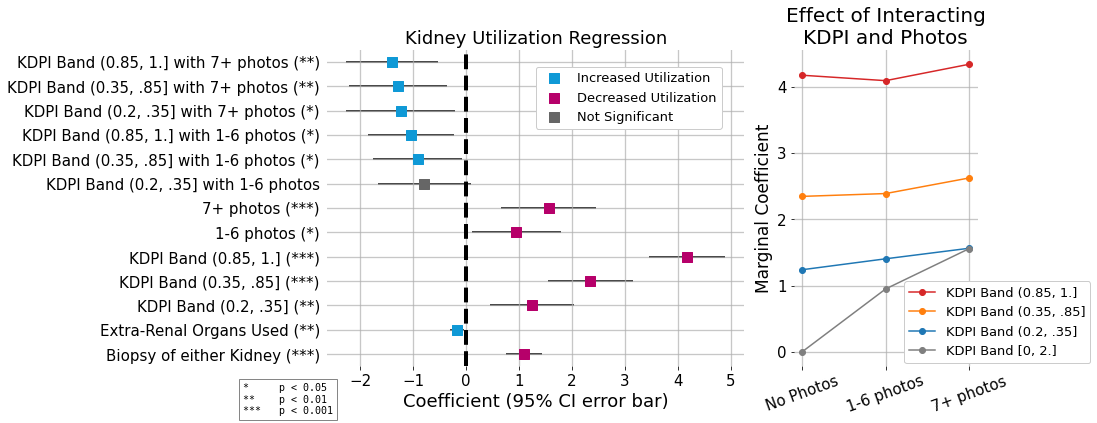DonorNet Procurement Photos and Their Association with Kidney Utilization
M. Stuart1, A. M. Placona1, C. Martinez1, K. Andreoni2
1United Network for Organ Sharing, Richmond, VA, 2University Hospitals, Case Western University, Cleveland, OH
Meeting: 2022 American Transplant Congress
Abstract number: 541
Keywords: Organ Selection/Allocation
Topic: Clinical Science » Organ Inclusive » 72 - Machine Learning, Artificial Intelligence and Social Media in Transplantation
Session Information
Session Name: Machine Learning, Artificial Intelligence and Social Media in Transplantation
Session Type: Rapid Fire Oral Abstract
Date: Tuesday, June 7, 2022
Session Time: 5:30pm-7:00pm
 Presentation Time: 6:30pm-6:40pm
Presentation Time: 6:30pm-6:40pm
Location: Hynes Room 210
*Purpose: Procurement teams can upload backbench photos of organs to DonorNet. It is unclear if these photos are associated with kidney utilization. We examined the associations between the use of organ procurement photos and kidney utilization.
*Methods: We collected attachment files (n=463,786) uploaded for deceased donors in 2019 utilizing the OPTN database. A preliminary analysis of metadata with a Random Forest model is used to help partition documents for further inspection. We then manually labeled a dataset of procurement photos (n= 2,874) and non-procurement photos (n= 1,988). We developed a classifier to identify procurement photos by leveraging the hidden layer outputs of a pre-trained canonical deep learning model (ResNet-18). The classification model was applied to all RGB photos with more than 1.5 million pixels (n=294,447).
We obtained a retrospective cohort of adult deceased kidney donors from 2019 with at least one kidney recovered for transplantation (n=10,262) and aggregate their total count of procurement photos. To increase certainty, we require predicted procurement photo likelihood to be at or above 0.9 for classification. The count of procurement photos is regressed against kidney discard, controlling for KDPI (Kidney Donor Profile Index), biopsy status, and the disposition of the donor’s other organs. Covariance is clustered on the Donor Service Area.
*Results: We identified 34,047 procurement photos using a novel machine learning methodology. With base level KDPI Band of [0, 2.], 1-6 photos (OR 2.58, CI 1.12, 5.97), more than 7 photos (OR 4.75, CI 1.94, 11.60), KDPI Band (0.2, .35] (OR 3.46, CI 1.56, 7.64), KDPI Band (0.35, .85] (OR 10.43, CI 4.67, 23.28), KDPI Band (0.85, 1.] (OR 64.76, CI 31.47, 133.26), and biopsy (OR 3.00, CI 1.56, 7.64) were each negatively associated with kidney utilization. Utilization of the donor’s extra-renal organs (OR 0.84, CI 0.74, 0.96) was positively correlated with kidney utilization.
We also interact KDPI with the number of photos and inspect the marginal effect of the interaction. Our partial dependency plot indicated that risk of decreased utilization associated with photos is attenuated for higher KDPI organs; for high KDPI organs, when 1-6 photos are present, there was a slight increase in utilization.
*Conclusions: The presence of procurement photos may affect allocation. While there is evidence that photos are associated with decreased utilization, the association is attenuated for higher KDPI kidney, potentially to help allocate high-risk organs. More research is needed to understand how photos are used.
To cite this abstract in AMA style:
Stuart M, Placona AM, Martinez C, Andreoni K. DonorNet Procurement Photos and Their Association with Kidney Utilization [abstract]. Am J Transplant. 2022; 22 (suppl 3). https://atcmeetingabstracts.com/abstract/donornet-procurement-photos-and-their-association-with-kidney-utilization/. Accessed December 18, 2025.« Back to 2022 American Transplant Congress

